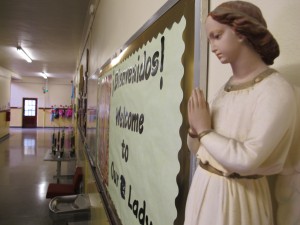Indiana's School Vouchers Cover Tuition For Parents Who Can Pay On Their Own

Kyle Stokes/StateImpact Indiana
A 'Holy Hall Monitor' near the front entrance of Our Lady of Hungary Catholic school in South Bend.
Among the biggest beneficiaries of Indiana’s expansive new voucher program are the parents who could have paid to send their kids to private school anyway.
Jeanetta White’s four foster kids went to public school last year. By this summer, she was fed up. White, 54, wanted to enroll them in private school — and she says she was willing and able to pay for it.
But White qualifies for Indiana’s new private school voucher program, so she doesn’t have to pay tuition at Our Lady of Hungary Catholic school in South Bend on her own.
“[My foster kids] were going to come anyway, but the voucher just pushed us over the threshold,” White says.
White gave a very frank interview to StateImpact. We’ve posted it here — she was blunt in her assessment of the public school where her kids were going:
- Foster Parent Sees Vouchers As Way Out Of Public SchoolsThe potential for the state’s voucher program to grow has worried advocates for public schools, who’ve filed a lawsuit saying it violates the separation of search and state.Download
It’s hard to know how many families like White’s there are among the state’s nearly 3,800 voucher recipients. But at Our Lady of Hungary, principal Melissa Jay says White’s story is typical among voucher families at the school: Many were interested in the school before the voucher program, and would have likely enrolled if they didn’t qualify.
At least in part, this is what state lawmakers intended when they crafted the program — to create the broadest, most inclusive voucher system in the country. Indiana’s program does allow families of four making as much as $62,000 per year to get some state help.
But IU education policy analyst Ashlyn Aiko Nelson says it’s also possible Indiana’s vouchers could fall into what has been a classic trap for similar programs across the country: the simple logistics of getting their kids to and from school become the biggest barriers to the parents who most need the tuition assistance a voucher program offers.
“What research has told us is that the parents of children who are most likely to be underserved are the least likely to be able to transport their children long distances to access better and higher-quality educational options,” Aiko Nelson told StateImpact.
Indiana State University education professor Terry McDaniel is reserving judgment on the program for now, but says public schools may not have to worry about population drain because of social factors. Parents, he says, simply want to send their children to the school where their friends are going.
“Will they get frustrated with their children going to this school while all of their friends are over here in another school? Or the kids that they play with in the ballpark and go to church with are in another school? We’ll have to wait and see,” McDaniel says.
Podcast: Play in new window | Download
